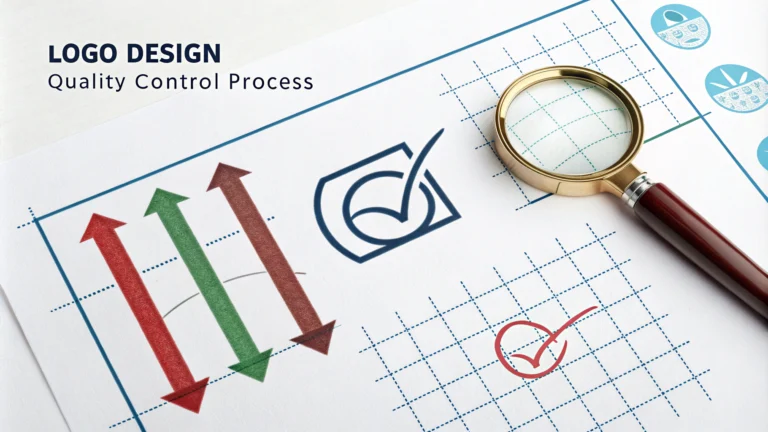A robust logo design quality control process helps deliver consistent, high-quality logos that meet client expectations and brand standards.
Initial Design Review
Each logo design should undergo thorough checks against the original design brief and client requirements.
- Technical specifications alignment
- Brand guidelines compliance
- Color accuracy and consistency
- Typography and spacing review
- Design originality verification
Technical Quality Checklist
- File format compatibility (AI, EPS, SVG, PNG, JPG)
- Resolution requirements for different applications
- Color mode accuracy (CMYK, RGB, Pantone)
- Vector scalability
- Font outlines and curves
Design Elements Assessment
Every logo should be tested for effectiveness across different scenarios and applications.
| Test Category | Check Points |
|---|---|
| Size Variations | Favicon size to billboard scale |
| Color Applications | Full color, monochrome, reverse |
| Background Tests | Light, dark, textured surfaces |
| Print Testing | Business cards, letterheads, merchandise |
Common Issues to Address
- Overlapping or misaligned elements
- Incorrect font conversions
- Color inconsistencies across applications
- Poor scalability at different sizes
- Trademark conflicts
Final Delivery Package
A complete logo package should include all necessary file formats and usage guidelines.
- Master vector files (AI, EPS)
- Web-optimized formats (PNG, JPG, SVG)
- Color variations (full color, black, white)
- Style guide with usage instructions
- Font information and licenses
Professional Resources
Connect with these organizations for additional logo design quality control guidance:
- AIGA (American Institute of Graphic Arts): www.aiga.org
- Graphic Artists Guild: graphicartistsguild.org
- Logo Design Love: www.logodesignlove.com
Regular quality control reviews help maintain high standards and prevent costly revisions later in the design process.
Client Review Process
Establishing a structured client review process ensures clear communication and timely feedback implementation.
- Initial concept presentation
- Feedback documentation system
- Revision tracking protocol
- Final approval documentation
- Change request management
Implementation Testing
Thorough testing across various platforms and mediums validates logo functionality and versatility.
Digital Applications
- Website headers and favicons
- Social media profiles
- Email signatures
- Mobile applications
Physical Applications
- Signage and displays
- Product packaging
- Vehicle wraps
- Promotional items
Documentation Requirements
| Document Type | Contents |
|---|---|
| Brand Guidelines | Logo usage rules and specifications |
| Technical Sheet | File formats and color codes |
| Implementation Guide | Application examples and restrictions |
| Version History | Design evolution and modifications |
Conclusion
A systematic logo quality control process is essential for delivering professional, versatile, and enduring brand identities. Regular reviews, comprehensive testing, and proper documentation ensure logos meet technical standards and client expectations while maintaining their integrity across all applications.
Implementing these quality control measures not only improves design outcomes but also streamlines the revision process and enhances client satisfaction. Regular updates to quality control procedures help design teams stay current with evolving industry standards and technological requirements.
FAQs
- What are the essential elements of a quality control process for logo design?
A quality control process for logo design includes initial client brief review, concept validation, technical specifications check, scalability testing, color consistency verification, file format compliance, typography review, trademark clearance, design versatility assessment, and final client approval. - How do you ensure logo colors remain consistent across different mediums?
Colors are checked using standardized color systems (Pantone, CMYK, RGB, HEX) and tested across various applications, both digital and print, to ensure consistency. Color values are documented and verified against brand guidelines. - What file formats should be included in the final logo deliverables?
Final logo files should include vector formats (AI, EPS, SVG), raster formats (JPEG, PNG), and PDF. Each format should be provided in color, black, and white versions, with appropriate resolution for different use cases. - How do you test logo scalability during quality control?
Logos are tested at various sizes, from very small (favicon size) to very large (billboard size), ensuring legibility and detail retention at all scales. Vector files are checked for clean paths and appropriate line weights. - What technical specifications should be verified during logo quality control?
Technical checks include proper vector construction, anchor point optimization, outline conversion of fonts, appropriate artboard sizing, correct color mode settings, and removal of unnecessary layers or hidden elements. - How do you check for potential trademark infringement issues?
Trademark verification involves searching existing trademark databases, conducting visual similarity searches, and documenting the design’s originality. This may include consulting legal professionals for clearance. - What spacing and alignment checks are necessary for logo quality control?
Spacing checks include verifying letter spacing, icon-to-text relationship, padding requirements, and alignment of all elements. Grid alignment and symmetry are verified where applicable. - How do you ensure the logo meets accessibility standards?
Accessibility checks include contrast ratio verification, legibility testing across different backgrounds, and ensuring the logo works in monochrome versions for various applications and vision-impaired viewers. - What documentation should accompany the final logo files?
Documentation should include brand guidelines specifying color codes, minimum size requirements, clear space rules, acceptable usage examples, file format explanations, and version control information. - How do you verify the logo’s cross-platform compatibility?
Cross-platform testing involves checking the logo across different devices, browsers, operating systems, and applications to ensure consistent display and functionality in all digital environments.








